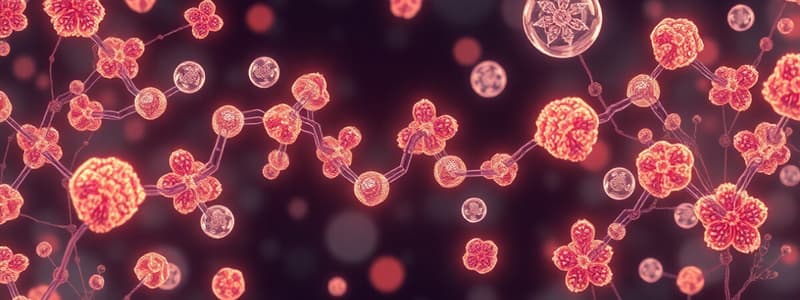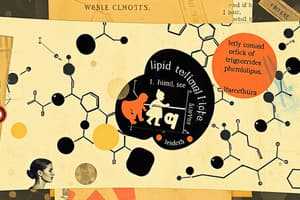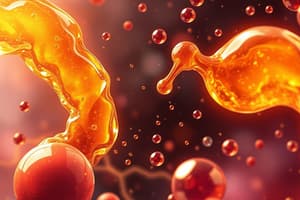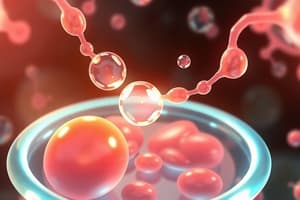Podcast
Questions and Answers
What is the primary function of triglycerides in animals?
What is the primary function of triglycerides in animals?
- Cell signaling
- Structural support
- Immediate energy source
- Long-term energy storage (correct)
Which enzyme is responsible for breaking down triglycerides?
Which enzyme is responsible for breaking down triglycerides?
- Protease
- Phospholipase
- Lipase (correct)
- Glycogenase
What differentiates phospholipids from triglycerides?
What differentiates phospholipids from triglycerides?
- Phospholipids have a phosphorylated head group (correct)
- Phospholipids are found only in archaea
- Phospholipids only form cell membranes
- Phospholipids contain no fatty acids
What is produced by the β-oxidation of fatty acids?
What is produced by the β-oxidation of fatty acids?
How do certain pathogens utilize extracellular proteases?
How do certain pathogens utilize extracellular proteases?
What is a characteristic feature of gelatinase produced by certain pathogens?
What is a characteristic feature of gelatinase produced by certain pathogens?
Which of the following statements is true regarding cholesterol degradation by pathogens?
Which of the following statements is true regarding cholesterol degradation by pathogens?
What happens to peptides after being taken up by cells?
What happens to peptides after being taken up by cells?
Flashcards are hidden until you start studying
Study Notes
Triglycerides
- Major source of long-term energy storage in animals.
- Composed of glycerol bonded to three fatty acids.
Phospholipids
- Integral components of cell and organelle membranes in all organisms, except archaea.
- Structurally similar to triglycerides but contain a phosphorylated head group instead of one fatty acid.
Breakdown Process
- Triglycerides and phospholipids are degraded by releasing fatty acids and/or phosphorylated head groups from the glycerol backbone.
- Lipases are enzymes that specifically catalyze the breakdown of triglycerides.
- Phospholipases are enzymes that target and break down phospholipids.
Microbial Enzyme Function
- Certain microbes, such as Staphylococcus aureus and Cryptococcus neoformans, utilize lipases and phospholipases to damage host cells and derive energy.
Products of Lipid Catabolism
- Degradation yields glycerol and fatty acids.
- Glycerol can convert to glycerol-3-phosphate, then to glyceraldehyde-3-phosphate, integrating into glycolysis.
- Fatty acids undergo β-oxidation, producing two-carbon acetyl groups along with NADH and FADH2 for ATP generation through oxidative phosphorylation.
- Acetyl groups are introduced into the Krebs cycle, resulting in the production of CO2, NADH, and FADH2.
Other Lipids
- Pathogens like Mycobacterium tuberculosis can degrade cholesterol to enhance virulence.
- The degradation of cholesterol involves the removal of side chains and a complex multi-step process for the fused rings, generating pyruvate for the Krebs cycle.
Proteins and Proteolysis
- Proteins are broken down by microbial enzymes known as proteases.
Extracellular Proteases
- Target specific amino acid sequences and cleave proteins into smaller peptides for cellular uptake.
Pathogen Identification via Proteases
- Certain pathogens produce unique extracellular proteases used for differentiation:
- Gelatinase, produced by Proteus and Serratia, prevents gelatin from solidifying when cultured in gelatin broth.
- Caseinase, found in Pseudomonas aeruginosa, creates a clear zone around colony growth on skim milk agar.
Further Breakdown of Peptides
- Uptaken peptides are further degraded into amino acids by intracellular proteases.
- Amino acids can undergo deamination, a process that involves the removal of the amino group.
Studying That Suits You
Use AI to generate personalized quizzes and flashcards to suit your learning preferences.




